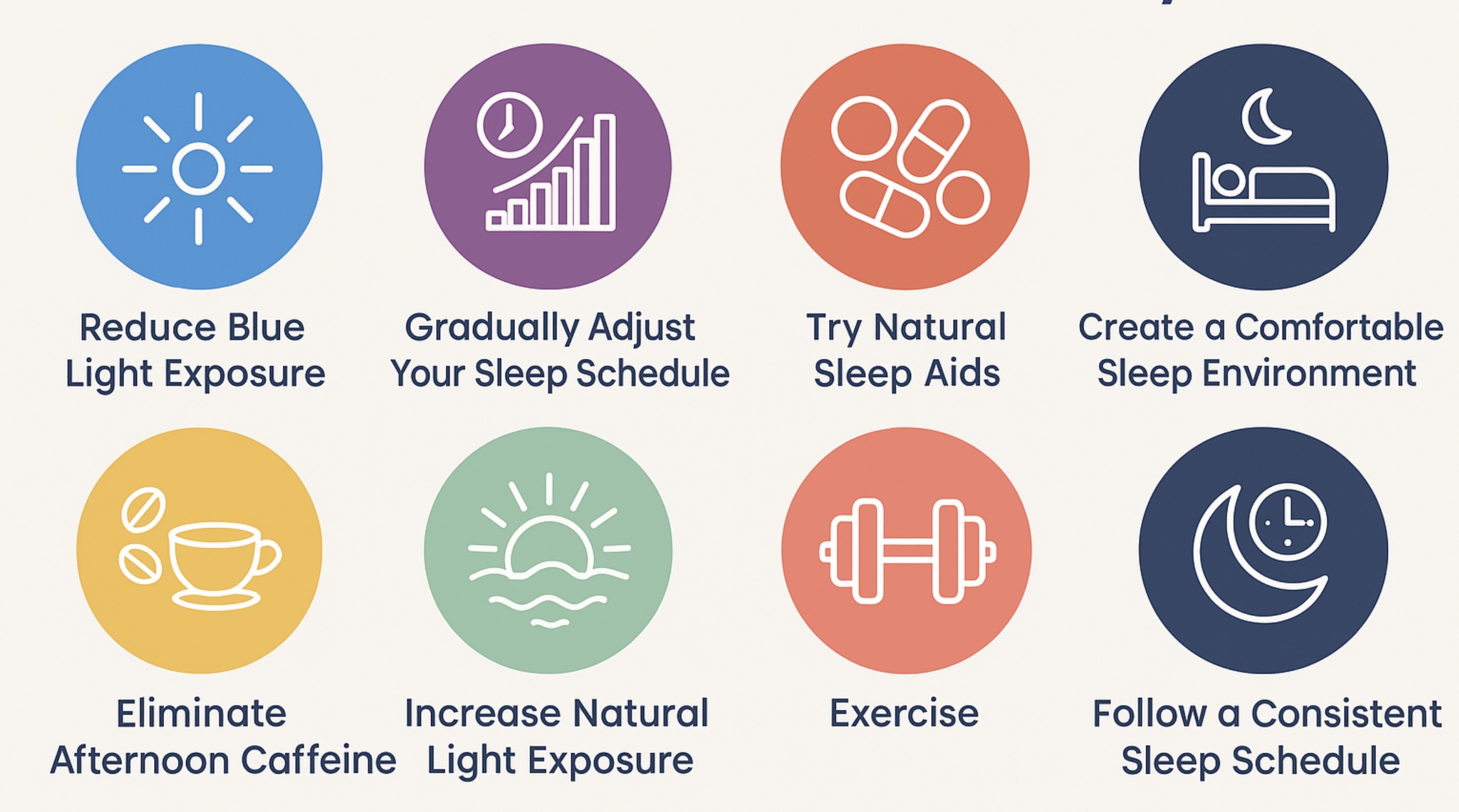
You might have heard about the benefits of sleeping earlier and you’ve tried it but your body and mind just can’t sleep earlier. You might have laid in bed just staring at the ceiling with your mind more awake than ever. If this has happened to you before, you're not alone. Up to 3% of adults suffer from circadian rhythm sleep disorders, and many more deal with delayed sleep patterns that interfere with their daily schedules. Whether you're preparing for an early work shift, trying to align with family routines, or simply wanting to optimize your mental health, shifting your bedtime earlier requires a strategic, science-based approach.
Successfully going to sleep earlier involves gradually shifting your circadian rhythm through strategic light exposure, consistent timing, and supportive sleep hygiene practices. Research shows this process typically takes 1-2 weeks when done properly. In this post, we will walk through the science behind your body’s internal clock and a step-by-step guide of how to go to sleep earlier.
Your ability to fall asleep is controlled by a 24-hour internal clock in your brain that regulates cycles of alertness and sleepiness. This circadian system, located in the suprachiasmatic nucleus (SCN) of your hypothalamus, operates like a master conductor orchestrating multiple biological processes and serves as your body clock.
The intrinsic circadian period is very tightly distributed around approximately 24.2 hours in most adults. This means your internal clock naturally runs slightly longer than a 24-hour day, requiring daily adjustments to stay synchronized with the earth's rotation.
Sleep regulation involves two key mechanisms working in tandem:
Sleep is most likely to be refreshing when your circadian rhythms align with natural light-dark cycles. When you try to sleep earlier than your circadian rhythm dictates, you're working against powerful biological forces in your body and mind.
There's a forbidden zone for sleep in the early evening when energy levels rise as part of your circadian rhythm, typically occurring 2-3 hours before your usual bedtime. During this period, falling asleep becomes nearly impossible unless you're severely sleep-deprived. This is why you might experience a wide-awake mind and racing thoughts when you’re trying to sleep earlier than usual.

Adults generally need at least seven hours of sleep for optimal health, making it crucial to work backward from your required wake time. For more detailed guidance on determining your ideal sleep duration, see our comprehensive sleep guide and use our sleep calculator.
Here are some action steps you can take:
Gradual changes are easier to implement than big sweeping adjustments and prevent the circadian disruption that causes lying awake at night.
Here are the gradual changes you can take to shift your timing:
This works because a gradual approach gives your body time to adjust without rebelling, allowing your circadian clock to naturally synchronize with the new schedule.
Light is the principal circadian synchronizer in humans, capable of shifting your internal clock when timed appropriately. You can learn more about optimizing your circadian rhythm for better sleep timing.
There are two important timings for “light” that you need to take note of.
Firstly, your morning light protocol involves:
Morning intermittent bright light combined with afternoon melatonin produced phase advances of 2.5-2.6 hours compared to 1.7 hours with placebo. Morning light signals to your body that it is time to wake up and start your day.
Secondly, your evening light protocol involves:
Sleep onset typically occurs during the downslope of core body temperature, and manipulating temperature can influence sleep timing. By cooling down your body temperature, your brain starts thinking that it is time for sleep. For specific recommendations, check out our guide on optimal sleep temperature.
In order to help regulate down your core body temperature when you’re getting ready for sleep, try these tips:
This works because core and brain cooling during NREM sleep increases expression of clock genes, reinforcing circadian rhythms and promoting deeper sleep.
We asked Dr. Michael Grandner, Sleep Expert and Professor of Neuroscience and Physiological Sciences, what his research can tell us about the relationship between temperature and sleep timing. He says:
"The circadian decline in core body temperature is one of the strongest biological signals for sleep onset. When we optimize our sleep environment to support this natural cooling process, we're essentially working with our biology rather than against it."
In other words, by creating conditions that support your body's natural temperature drop, you can make falling asleep at an earlier time significantly easier.
Melatonin administration several hours before its endogenous peak effectively advances sleep time. Before considering melatonin, review our detailed guide on melatonin dosage and side effects and explore natural sleep alternatives. While melatonin is one of the most researched sleep aids, it's important to understand proper timing and dosing.
Here is a suggested protocol (remember to always consult your healthcare provider first):
An important note is that melatonin timing is crucial. Taking it at the wrong time can delay rather than advance your circadian clock. Additionally taking too little or too much can produce the wrong effects so do your research before using melatonin.
Following the same steps each night reinforces in your mind that it's bedtime. What you want to do is train your brain to associate the same pre-sleep routine with a trigger for bringing on sleep. A consistent bedtime routine signals to your body that sleep time is approaching. For comprehensive guidance on creating effective evening routines, see our sleep hygiene tips.
Here are some pre-sleep routines that you could implement:
Lastly, all of these steps above need to be combined with overall lifestyle changes. Doing a consistent pre-sleep routine isn’t going to be helpful if you’re guzzling a cup of coffee right before bed or if you’re eating a large meal 30 minutes before trying to sleep.
Once you work on these steps, here’s what you can expect week after week. Change doesn’t happen overnight so try and be patient with your mind and body!
How long adjustment takes depends on how much you're changing your schedule:
A groundbreaking study published in the Journal of Clinical Endocrinology & Metabolism investigated whether combining morning bright light with afternoon melatonin could enhance circadian phase advancement beyond either treatment alone.
Study Design: 44 healthy adults underwent 3 days of treatment with gradually advancing sleep schedules, morning intermittent bright light (four 30-minute pulses at ~5000 lux), and either 0.5mg melatonin, 3.0mg melatonin, or placebo taken in the afternoon.
Key Findings:
Clinical Implications: This research demonstrates that strategically combining multiple chronobiological interventions can accelerate the process of shifting to earlier sleep times while minimizing the discomfort typically associated with schedule changes.
Real-World Application: For individuals needing to advance their sleep schedule by 2+ hours, combining morning light therapy with properly timed melatonin (under medical supervision) may reduce adjustment time from weeks to days.
You might have tried some of these steps before but they didn’t work for you. Here are some reasons why they might not have worked:
Attempting to shift bedtime by several hours overnight typically backfires, leading to lying awake frustrated and potentially developing negative sleep associations. If you're struggling with this, our article on what to do when you can't sleep provides helpful strategies.
Consistency is critical for creating a sleep schedule. Weekend variations can undo weekday progress. Learn more about why your sleep hygiene matters for long-term success.
Many people focus only on bedtime without addressing the light-dark cycle that drives circadian rhythms.
Individual differences in circadian timing can be amplified by artificial light exposure patterns, meaning some people naturally require more time to adjust.
Individuals with intrinsic circadian periods longer than 24.2 hours may experience significant mismatch between weekday and weekend sleep times. These individuals may benefit from:
Circadian rhythms begin developing shortly after birth but shift later during puberty. Adolescents naturally experience delayed sleep phase, making earlier bedtimes particularly challenging and potentially requiring modified approaches.
If you're still waking up tired despite following these steps, explore our guide on why you might not feel rested after sleep.
Consider consulting a sleep medicine specialist if:
For a structured approach to sleep improvement, consider cognitive behavioral therapy for insomnia (CBT-I) or sleep coaching as evidence-based alternatives to medication.
Going to sleep earlier isn't just about willpower—it's about working with your biology rather than against it. By understanding how your circadian system functions and implementing evidence-based strategies, you can successfully shift your sleep schedule while maintaining sleep quality and daytime functioning.
The key is patience, consistency, and a multi-faceted approach that addresses light exposure, timing, temperature, and behavioral factors. The best treatment for long-term sleep improvement is proper sleep hygiene through behavior modification, making these strategies not just effective for schedule changes, but beneficial for lifelong sleep health.
Remember: Sleep hygiene has little cost and virtually no risk, making it an accessible starting point for anyone looking to optimize their sleep timing and overall health.
For additional evidence-based strategies to improve your sleep, explore our comprehensive guides on 10 tips to improve your sleep and how to improve sleep quality at home.
This article is for educational purposes only and should not replace professional medical advice. Consult with a healthcare provider before making significant changes to your sleep schedule or using supplements like melatonin.

Dr. Shiyan Yeo
Dr. Shiyan Yeo is a medical doctor with over a decade of experience treating patients with chronic conditions. She graduated from the University of Manchester with a Bachelor of Medicine and Surgery (MBChB UK) and spent several years working at the National Health Service (NHS) in the United Kingdom, several Singapore government hospitals, and private functional medicine hospitals. Dr. Yeo specializes in root cause analysis, addressing hormonal, gut health, and lifestyle factors to treat chronic conditions. Drawing from her own experiences, she is dedicated to empowering others to optimize their health. She loves traveling, exploring nature, and spending quality time with family and friends.